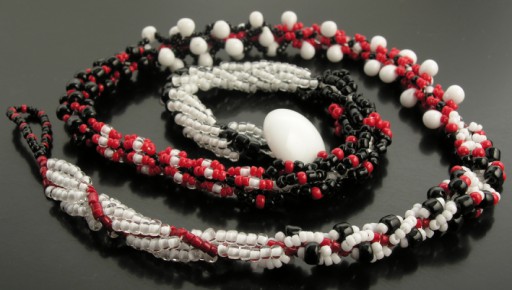I enjoyed all the classes I took at Glassact's second (or was it third?) annual retreat, and I learned something in all of them as well, even though I mostly went to have a good time. But this class was my favorite because it was so completely relaxing. Perhaps part of that was my total lack of expectations. Though I have fairly extensive experience with seed bead techniques, I haven't done them regularly since I took up lampworking, over a decade ago; they, like drawing, are now a hobby, done for fun.
My friend Margaret taught the class: in some ways, we reverse each other, as seed bead work has really become her passion, though she does more fusing and lampworking than I do beadweaving. She's also an extremely organized person, and as such presented us with excellent directions accompanied by diagrams for the technique, along with numbered bags for each section of the project, which obstensibly was a bracelet.
The class was designed to give seed-bead phobic lampworkers an opportunity to get their feet wet, or rather, their fingers accustomed with what Margaret considers to be the easiest of techniques, and one easily geared to incorporating lampwork: she had a wonderful necklace done in this style, in banana-peel yellow, tangerine orange, lime green and bright turquoise, featuring beads she'd made to match, and it was very effective. After debating whether to make the black and white kit accents blue-green or red, she went with the former, so of course we all wanted the latter—I actually thought the seafoam more attractive, but I wanted the bracelet to match my fimo necklace, (which after being lost for the last 4 years, finally turned up while I was looking for something I needed for my retreat class!) so I begged to get the red and Margaret was kind enough to indulge me.
She very sensibly started us with the size 8/0 and 11/0, the former serving as the "core" (this is the button end of the piece, in the center of the photo); as we progressed through the variations, we worked with drops, 15/0s and the like. Since I'm pretty comfortable with seed beads, I usually added another variation or two to each of the five sections she taught, which is why my piece is long enough to go around the wrist twice. Cindi, our current prez, helped round out the beads that came with the kit with a few extras, and I finished the project at home, virtuously limiting myself (mostly, anyway;) to the beads provided.
As I mentioned in the intro, I learned something in every class, even this one—and as is so often the case not necessarily what I was expecting. The most valuable thing I took from this workshop is the considerable improvement in beading thread over the past few years. Margaret's fave is something called 1G, and it's fabulous stuff—very little knotting and no shredding. Instead of coating it with wax, we carefully and slowly stretched between tight fingers (or in my case, folded paper since I promptly gave myself friction burns using the pads of my fingers) to remove the curls. This thread (and its main competitor, the name of which I forget) is great, and I recommend it highly.
Because I think it's kind of frustrating for teachers when students take home the projects they're so enthusiastic about during class and then never touch them again I figured I should just finish this up right away. So I did, and here it is, testament to a most enjoyable Sunday morning.
file created 29feb08, full-size image substituted 17apr14.
Unless otherwise noted, text, image and objects depicted therein copyright 1996--present sylvus tarn.
Sylvus Tarn